
Only weeks after Millie Smith and Lewis Cann learned they were having twin baby girls, they learned that only one would survive.
On April 30, after 30 weeks of a high-risk pregnancy, Smith delivered identical twins, Callie and Skye, the latter who lived only three hours.
Later in neonatal intensive care unit (NICU), Callie slept without her sister in the incubator, with her loving and grieving parents watching over her. In the unit with other babies, an overwhelmed mom of healthy newborn twins innocently told Smith that she was “so lucky” to not have two babies.
Crushed by the words, the new mom couldn’t find the words to explain her loss. Then, she realized that Skye’s legacy was to help other families who lose a child, and it came in the form of a purple butterfly.
In November 2015 Millie Smith and partner Lewis Cann found out they were having their first Child. Smith, who has twins in the family, said she had a “gut feeling” about having a duo and 10 weeks later, doctors confirmed she was expecting identical twin girls.
Less than two weeks after the excitement of knowing they would double the children in their home, the British couple were devastated to learn that one of their babies had a fatal condition and wouldn’t survive after birth.
“During the scan, the doctor didn’t say anything. I was very excited and loved seeing the little babies, but she was silent. Both Lewis and I immediately knew there must be a problem,” Smith said.
Doctors shared the news that one of the babies had anencephaly, which according to the Centers for Disease Control and Prevention (CDC) affects about one in 4,600 babies across the U.S. It’s a serious birth defect where a baby is born without parts of the brain and skull, and “almost all babies born with anencephaly will die shortly after birth.”
Knowing that one baby would die soon after birth, and that there were risks involved for their other baby, the couple decided to move forward with the extremely high-risk pregnancy.
Over the next several months, Smith and Cann named their twins Skye and Callie. “We knew that Skye needed to have a name before she was born,” Smith said. “Knowing she would only survive for seconds or minutes, I wanted her to be named during that time.”
The meaning behind “Skye,” she explained “was somewhere we knew she would always be, that we could look up at the sky and remember our baby.”
When Smith went into labor after only 30 weeks on April 30, she needed an emergency C-section. To help navigate the loss, the couple had a “bereavement midwife” during the birth, and they were put I a special room the called the “Daisy Room,” where families can spend time with a baby before and after she/he passes.
“When the girls were born, they both cried. This was a huge moment, as we were told that Skye would not make a noise or move,” said Smith, who was thankful to have three hours with Skye before she died. “We were cuddling Skye when she passed away. This was the worst moment in our lives. I have never ever felt heartbreak like that before. But I am proud that she fought for so long to spend time with us.”
Born premature, Callie had to stay in NICU while she gained some strength and also in the unit were three other sets of twin.
“Most of the nurses were aware of what had happened, but as time passed, people stopped talking about Skye. After about four weeks, everyone acted as though nothing had happened, meaning the families around me had no idea about our situation,” Smith recalled.
One morning, a stressed mother whose twins were also in NICU, harmlessly said to Smith that she was “so lucky” to not have twins.
“None of the other parents knew what had happened or anything about Skye. The comment was completely innocent and more out of humor…They weren’t to know that I did at one point have two.” Smith continued, “But the comment nearly broke me. I ran out [of] the room in tears and they had no idea why. I didn’t have the heart to tell them what had happened. A simple sticker would have avoided that entire situation.”
It was in that moment Smith realized she had to create something that would speak for parents who had just lost a baby, ensuring the misunderstanding never happens again.
She designed a poster for the NICU explaining both hospital personnel and visitors that any incubator with a purple butterfly on it means that one or more babies, in a set of multiples were lost.
“I chose butterflies, as I felt it was fitting to remember the babies that flew away, the color purple because it is suitable for both boys or girls,” said Smith.
The purple butterfly concept–now under the Skye High Foundation–has spread to hospitals in several countries around the world.
Callie is now a lively, happy seven-year-old, and twin’s memory lives in purple butterfly cards along with other initiatives to help families with babies like Skye all over the world. The purple butterflies now come in numerous forms, like ornaments, cards, blankets, stuffed animals and more.
“Ultimately I will never be able to stop this from happening but the more support groups we can set up and put things in place like the stickers the better it will be. It’s the hardest thing anyone has to deal with,” Smith said.
Herdeiros gananciosos tentaram ganhar o favor do avô para herdar mais — seus queixos caíram quando o advogado leu o testamento

Em seus últimos dias, o Sr. Lewis viu através dos gestos vazios de sua família. Mas ninguém esperava a reviravolta quando a gentileza simples de uma jovem virou tudo de cabeça para baixo na leitura de seu testamento.
O Sr. Lewis recostou-se em sua cadeira de couro favorita, aquela que o havia apoiado em inúmeras sessões de trabalho até altas horas da noite, e refletiu sobre a vida que havia construído. Aos 83 anos, ele tinha visto de tudo.

Um homem idoso sorri enquanto olha pela janela | Fonte: Midjourney
Ele começou do nada, trabalhando incansavelmente para construir seu negócio e, quando chegou aos 40 anos, já tinha feito seu nome no mundo. Mas não era só a riqueza que o definia.
O Sr. Lewis passou a vida fazendo o bem, criando uma família de oito filhos, quatro biológicos e quatro adotados, e abrindo sua casa para crianças adotivas que não tinham para onde ir.
“Você sempre tem espaço para mais um, não é?”, sua falecida esposa costumava dizer com um sorriso suave, observando-o acolher cada nova criança em suas vidas.

Uma mulher de meia idade sorri suavemente enquanto olha para alguém | Fonte: Midjourney
O Sr. Lewis nunca hesitou. Ele acreditava em retribuir, seja por meio de doações de caridade ou sendo um pai para aqueles que precisavam.
Mas conforme os anos passaram e as crianças cresceram, as coisas mudaram. Sua casa antes movimentada tornou-se assustadoramente silenciosa. Seus filhos, tanto biológicos quanto adotados, raramente o visitavam, a menos que precisassem de algo. As conversas sempre começavam do mesmo jeito.
“Pai, você sabe como é difícil lá fora”, Richard, seu filho mais velho, dizia, mal fazendo contato visual. “Eu só preciso de uma ajudinha para passar por este mês.”

Um homem parece frenético enquanto fala com alguém | Fonte: Midjourney
Olivia, sua filha, não era muito diferente. “Pai, as taxas escolares das crianças são absurdas. Você poderia apenas—” ela começava, e antes mesmo de terminar, ele estava pegando seu talão de cheques.
Os netos não eram melhores. Eles só apareciam durante os feriados, olhando para ele como se ele fosse um cofre de banco ambulante. Ele amava os netos, mas não conseguia ignorar a verdade desconfortável; eles estavam sendo criados para vê-lo como um meio para um fim, não uma pessoa.
Quando o Sr. Lewis fez 83 anos, seu médico deu um diagnóstico de partir o coração. “Você tem cerca de um mês, Sr. Lewis. Sinto muito.”

Um médico falando com um paciente idoso | Fonte: Midjourney
As palavras ecoaram em seus ouvidos, mas ele as encarou com a dignidade silenciosa que havia demonstrado durante toda a sua vida. Naquela noite, ele ligou para seus filhos e netos para compartilhar as notícias.
Em poucas horas, eles se aglomeraram em sua mansão vindos de todo o mundo. Richard apareceu com sua esposa e três filhos, fingindo ser o filho devotado.
Olivia veio em seguida, com suas duas filhas a tiracolo, esboçando um sorriso que mais parecia uma careta. Até mesmo seus filhos adotivos, espalhados pelo globo, de repente encontraram tempo para largar tudo e voltar para casa.

Um idoso doente deitado na cama parece surpreso | Fonte: Midjourney
“Pai, não se preocupe, já chegamos”, disse Richard, dando um tapinha no ombro do pai com afeição forçada.
“Estamos com você, vovô”, disse uma das netas, Willow, uma adolescente que passava a maior parte do tempo grudada no celular.
Por semanas, eles o cercaram, cobrindo-o de sorrisos falsos e palavras vazias. “Posso te trazer alguma coisa, pai?”, Olivia perguntava, entregando a ele uma xícara de chá que ela não se preocupou em fazer.

Uma xícara de chá sobre uma mesa | Fonte: Midjourney
“Você deveria descansar, vovô. Nós cuidaremos de tudo”, acrescentou o filho mais novo de Richard, Derek. Os olhos do menino permaneceram nas pinturas ornamentadas que cobriam as paredes, como se já estivesse catalogando mentalmente a herança do avô.
O Sr. Lewis observou tudo se desenrolar com o coração pesado. Ele conseguia ver através da farsa. Eles não estavam lá por amor, mas pelo dinheiro. Eles tropeçaram um no outro, tentando ganhar seu favor e garantir sua fatia da torta antes que ele fosse embora. Mas o Sr. Lewis não era bobo.

Um homem idoso doente parece pensativo e triste enquanto está deitado na cama | Fonte: Midjourney
Quando ele finalmente faleceu, silenciosamente em seu sono, os filhos e netos não perderam tempo voltando sua atenção para o que realmente importava para eles: a herança. O dia da leitura do testamento não foi diferente. Eles se amontoaram no escritório do advogado, inquietos e ansiosos, sua tristeza fingida há muito esquecida.
“Aposto que ele deixou muito para mim”, Olivia murmurou baixinho, sua voz cheia de direito.
“Você está delirando”, Richard retrucou, sorrindo. “Papai sempre disse que eu tinha o melhor senso de negócios.”

Um homem conversando com alguém no escritório de um advogado | Fonte: Midjourney
Eles continuaram com suas pequenas brigas até que a porta se abriu. O Sr. Alaric, o advogado da família, entrou, e ao lado dele estava uma garotinha, não mais velha que treze anos. Ela entrou silenciosamente, sua presença inesperada e confusa para a sala de herdeiros briguentos.
“Quem é o garoto?”, Richard perguntou abruptamente, seu sorriso maroto desaparecendo.
“Esta”, começou o Sr. Alaric, sua voz carregando uma sugestão de algo que nenhum deles conseguia identificar, “é Harper. Ela está aqui para a leitura do testamento.”

Um advogado em pé em seu escritório olhando para as pessoas à sua frente | Fonte: Midjourney
A confusão tomou conta da sala enquanto os herdeiros trocavam olhares perplexos. Pela primeira vez, seus sorrisos confiantes e gananciosos começaram a vacilar. Harper, uma figura quieta em meio a uma tempestade de ganância, estava ali, sem saber, segurando a chave para uma reviravolta que nenhum deles viu chegando.
A sala estava cheia de um silêncio desconfortável enquanto o Sr. Alaric embaralhava seus papéis, o som de páginas nítidas ecoando na atmosfera tensa. Os filhos e netos do Sr. Lewis estavam sentados impacientemente, seus olhos disparando um do outro para a garotinha parada calmamente ao lado do advogado.
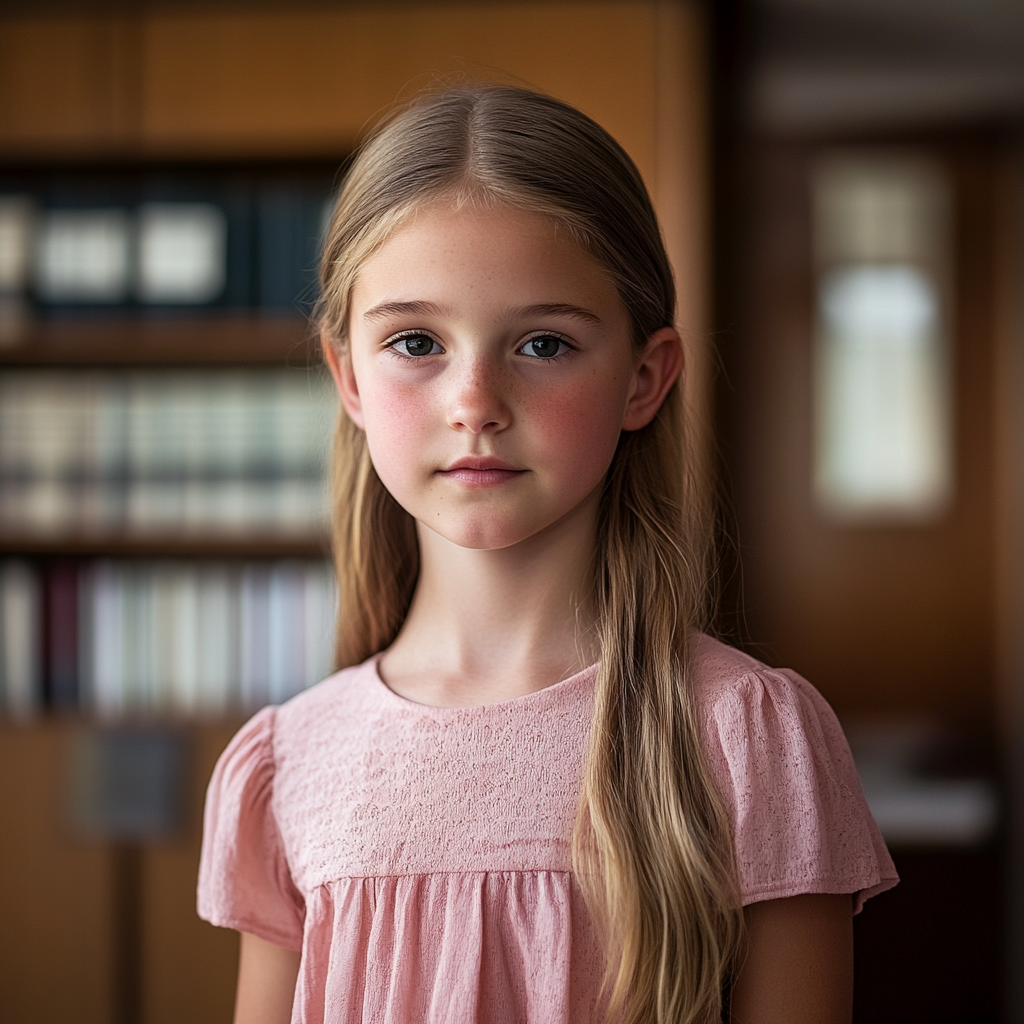
Uma menina de 13 anos em pé no escritório de um advogado | Fonte: Midjourney
Harper, com seus olhos arregalados e comportamento inocente, parecia tão deslocada entre os abutres adultos circulando o que eles acreditavam ser sua presa.
O Sr. Alaric limpou a garganta, quebrando o silêncio. “Nenhum de vocês sabe disso, mas Harper está aqui hoje porque o Sr. Lewis a tornou a única herdeira de toda a sua fortuna.”
A sala explodiu. Richard se levantou de um salto do assento, o rosto vermelho de raiva. “Do que diabos você está falando? Ela é só uma criança! Papai não faria isso.”

O rosto de um homem está vermelho de raiva e decepção | Fonte: Midjourney
A voz de Olivia era cortante, quase histérica. “Isso é ridículo! Nós somos filhos dele, sangue dele! Isso é uma farsa, certo? Diga que isso é algum tipo de piada doentia!”
O Sr. Alaric levantou a mão, sinalizando para que ficasse quieto. “Eu entendo que isso é chocante, mas a decisão do Sr. Lewis foi tomada com total entendimento do que ele queria. Ele deixou uma carta explicando tudo. Vou ler agora.”
O advogado desdobrou a carta e a sala ficou em silêncio, embora a tensão ainda pairasse no ar.

Um advogado lendo um testamento em pé em seu escritório | Fonte: Midjourney
Querida família, o Sr. Alaric começou, sua voz firme. Eu sei que vocês provavelmente estão furiosos, confusos e talvez até magoados com minha decisão. Mas eu preciso que vocês me ouçam. Nos últimos anos, Harper tem sido a luz na minha vida. Ela é a garotinha que morava ao lado com os pais. Ela percebeu, muito antes de qualquer outra pessoa, que eu não estava bem. Ela me via lutando para pegar a correspondência ou apenas sentada sozinha na varanda.
Harper se mexeu desconfortavelmente enquanto todos os olhos se voltavam para ela, mas ela permaneceu em silêncio, com as mãos firmemente entrelaçadas.

Uma menina de 13 anos parece um pouco desconfortável enquanto está no escritório de um advogado | Fonte: Midjourney
Harper me visitava todos os dias. Ela não queria nada de mim: nem dinheiro, nem favores. Ela só vinha, me contava piadas, jogava cartas ou lia histórias para mim. Ela me fazia sentir menos sozinho. Harper tem sido minha verdadeira família nos últimos anos, quando todos vocês estavam ocupados com suas próprias vidas.
Richard zombou, balançando a cabeça. “Estávamos ocupados fazendo nossas vidas funcionarem, pai. Você deveria ter nos dito que estava solitário.”

Um homem em pé com os braços cruzados | Fonte: Midjourney
Mas o Sr. Alaric continuou lendo, sem se abalar com as interrupções. Harper tem suas batalhas para lutar. Alguns meses atrás, ela foi diagnosticada com uma doença terminal — uma que nenhuma criança deveria enfrentar. Eu vi como ela se ilumina quando fala sobre seus sonhos, os lugares que ela quer ver e as coisas que ela quer fazer. Ela merece ter a vida que sonha, não importa quão curta ela seja.
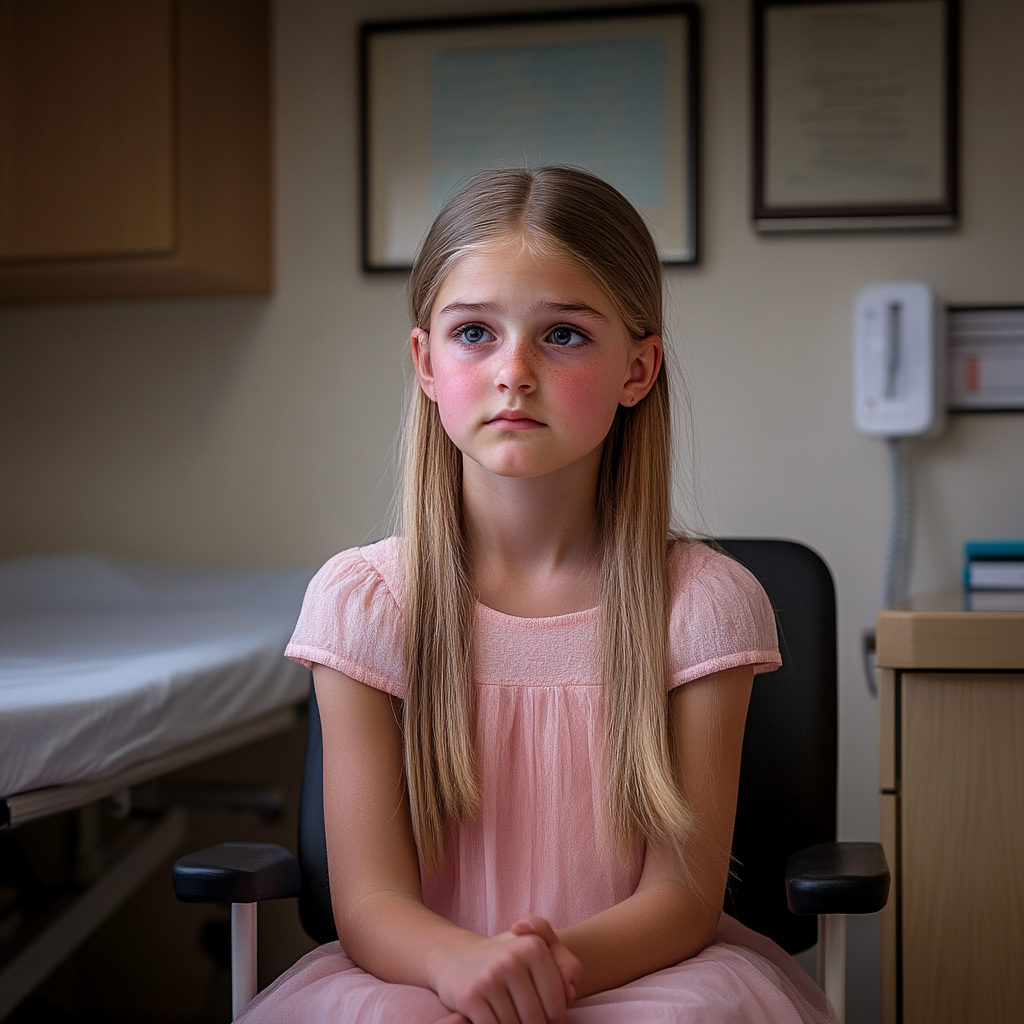
Uma menina de 13 anos sentada em uma clínica médica | Fonte: Midjourney
A sala ficou em silêncio, o peso das palavras do Sr. Lewis se fez presente. Até Olivia, que estava furiosa momentos antes, ficou sentada em silêncio, com lágrimas nos olhos.
Quando você ler isso, eu já terei ido embora, continuou a carta. E Harper pode ter apenas um ou dois anos restantes. Eu me certifiquei de que ela tenha tudo o que precisa para viver esses anos ao máximo. E no meu coração, eu sei que é a coisa certa a fazer.

Um homem idoso sorri enquanto assina seu testamento | Fonte: Midjourney
Então, em vez de brigar pelo que deixei para trás, espero que vocês encontrem forças para apoiar essa garotinha que fez o que nenhum de vocês fez: ela se importou.
O Sr. Alaric dobrou a carta e, por um momento, a sala foi preenchida com o som pesado de silêncio atordoado. Ninguém sabia o que dizer. Richard e Olivia se entreolharam, e a realidade das palavras do pai os atingiu mais forte do que qualquer disputa de herança jamais poderia.

Um homem e uma mulher ficam surpresos e sem palavras | Fonte: Midjourney
Harper deu um passo à frente, sua voz baixa, mas clara. “O Sr. Lewis era meu amigo. Ele me fazia rir quando eu não tinha vontade de sorrir. Eu nunca quis seu dinheiro, apenas suas histórias e seu tempo.”
Richard limpou a garganta, tentando disfarçar seu constrangimento. “Garoto… quero dizer, Harper, eu—” Ele lutou para encontrar as palavras. “Desculpe. Eu não sabia.”

Um homem parece envergonhado | Fonte: Midjourney
Harper apenas assentiu, seu olhar inabalável. “Vou usar o dinheiro para fazer tudo que sempre quis com meus pais. Vamos viajar, tomar sorvete no café da manhã e passar um tempo juntos. E quando eu me for, o resto vai para crianças como eu, que estão lutando para ter um pouco mais de tempo.”
Lágrimas escorriam pelas bochechas de Olivia agora. “Você é… tão corajosa, Harper. Espero que você consiga fazer tudo o que quiser.”
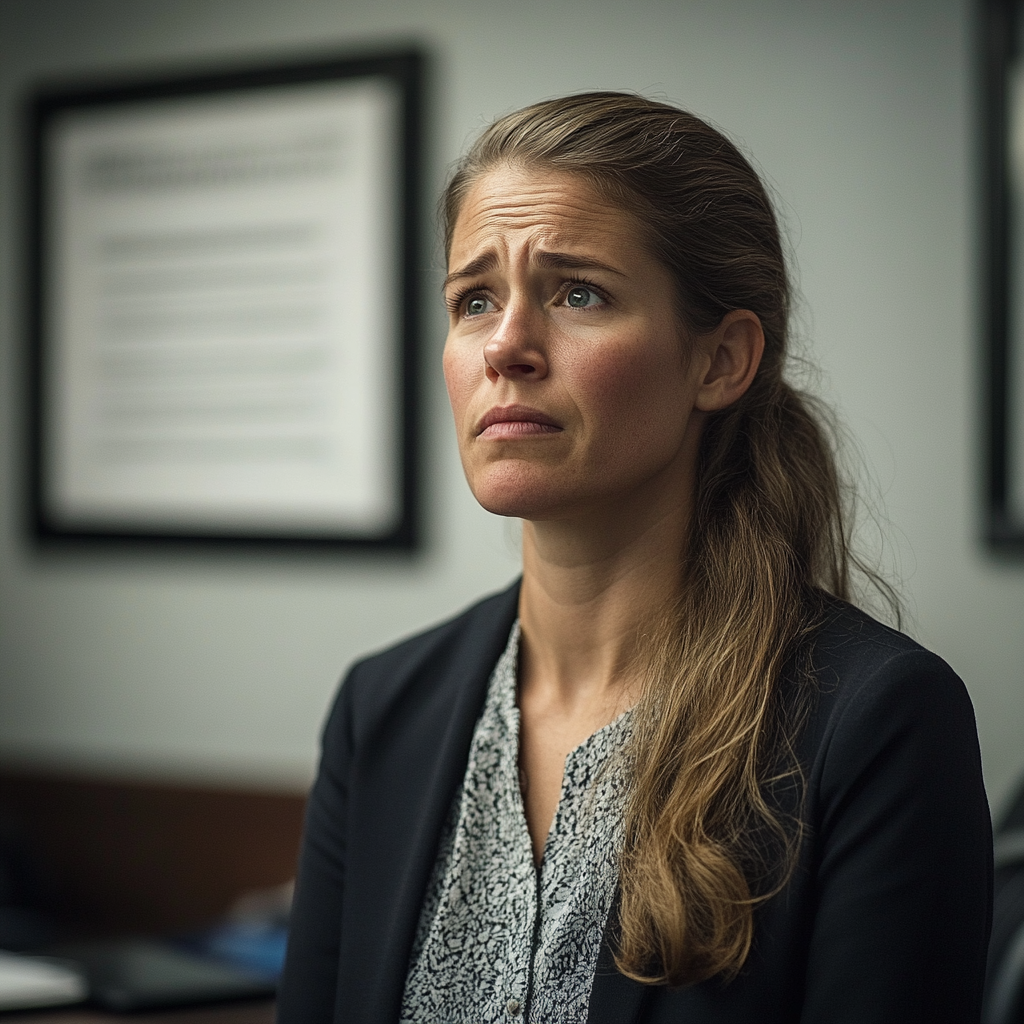
Uma mulher emocionada e com os olhos marejados em pé no escritório de um advogado | Fonte: Midjourney
Nos meses seguintes, Harper fez exatamente o que prometeu. Ela viveu cada dia ao máximo, passando cada momento que podia com seus pais, visitando lugares com os quais ela apenas sonhava e criando memórias que durariam muito além de seus anos.
Ela viu a Torre Eiffel, mergulhou os dedos dos pés no oceano e riu mais do que nunca. E quando chegou a hora, ela faleceu em paz, cercada por aqueles que amava.
Conforme seus desejos, a fortuna restante foi doada a instituições de caridade que apoiavam crianças que lutavam contra o câncer, financiavam pesquisas e forneciam apoio a famílias necessitadas.

Uma menina sofrendo de câncer segurando uma boneca enquanto faz tratamento | Fonte: Freepik
O legado de Harper se tornou um farol de esperança para inúmeras outras pessoas, um lembrete do poder da gentileza e do impacto de uma conexão única e genuína.
Os filhos do Sr. Lewis, mudados para sempre pela coragem de Harper e pela lição final do pai, se sentiram inspirados a viver de forma diferente. O dinheiro pelo qual eles estavam desesperados não era mais o que importava. No final, foi o espírito inabalável de Harper que os ensinou o verdadeiro valor da vida e do amor.
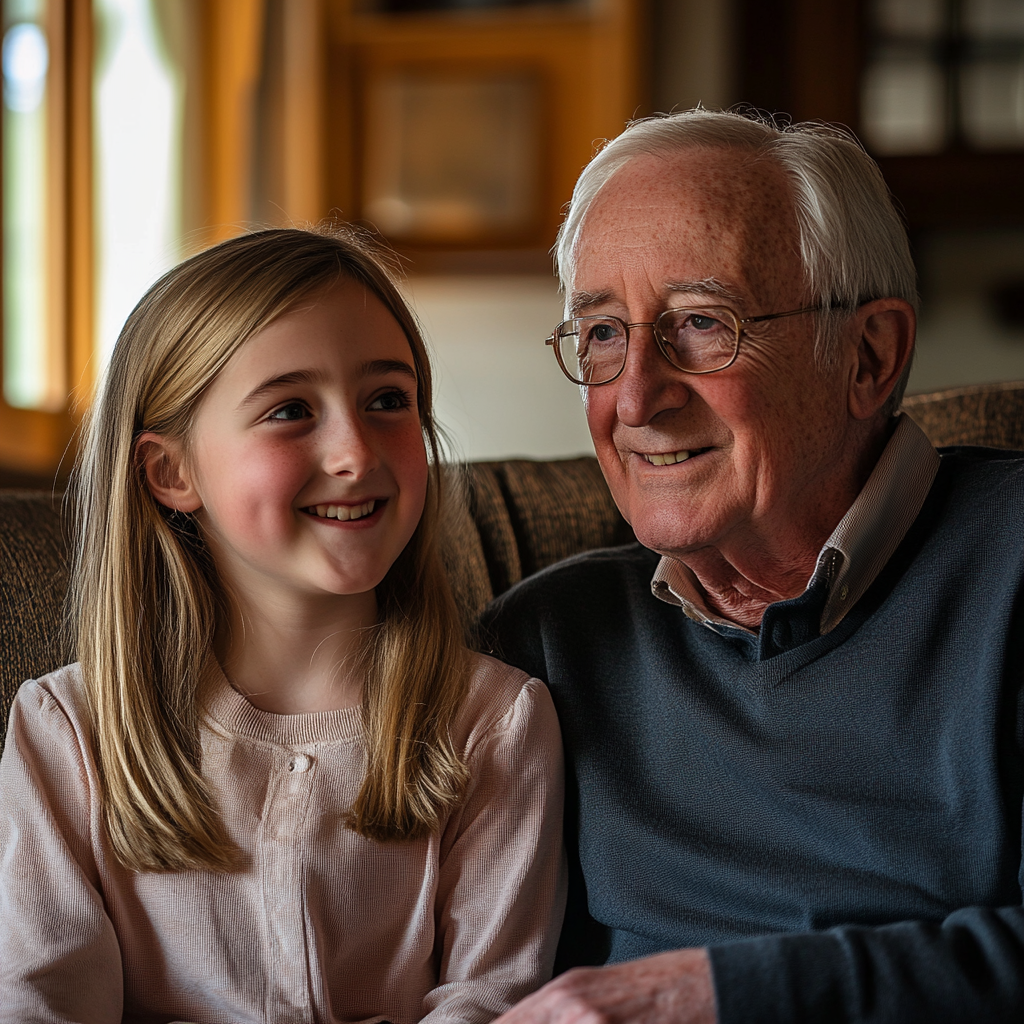
Uma menina de 13 anos e um homem idoso passando um tempo juntos | Fonte: Midjourney
Quando meus irmãos e eu chegamos à cabana do nosso falecido avô, achamos que estávamos competindo por sua fortuna. Mal sabíamos que o vovô Brooks tinha um último truque na manga que testaria nossos laços de maneiras que nunca imaginamos.
Este trabalho é inspirado em eventos e pessoas reais, mas foi ficcionalizado para fins criativos. Nomes, personagens e detalhes foram alterados para proteger a privacidade e melhorar a narrativa. Qualquer semelhança com pessoas reais, vivas ou mortas, ou eventos reais é mera coincidência e não intencional do autor.
O autor e a editora não fazem nenhuma reivindicação quanto à precisão dos eventos ou à representação dos personagens e não são responsáveis por nenhuma interpretação errônea. Esta história é fornecida “como está”, e quaisquer opiniões expressas são as dos personagens e não refletem as opiniões do autor ou da editora.

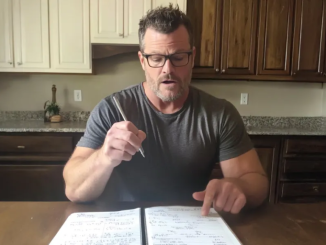
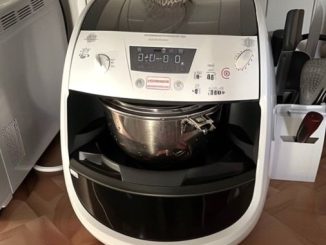
Leave a Reply